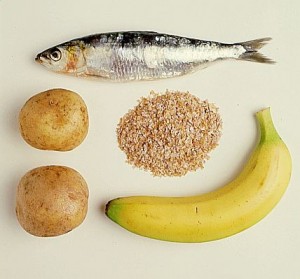|
|
|
Home | Pregnancy Timeline | News Alerts |News Archive Mar 13, 2015

Vitamins B, C and E are mostly found in fresh and colorful fruits and vegetables
while Vitamin D and Omega 3 fatty acids are found in large quantity in fish. |
|
|
|
|
|
Low Omega-3 and Vitamin D affects brain serotonin
Although omega-3 fatty acids and vitamin D have been seen to improve cognitive function and behavior in certain brain disorders, low levels of omega-3 fatty acids and vitamin D will negatively affect brain development and function as well.
Rhonda Patrick PhD and Bruce Ames PhD of Children's Hospital Oakland Research Institute (CHORI), believe serotonin may be the missing link behind why vitamin D and essential marine omega-3 fatty acids improve symptoms of some brain disorders. Their paper is published in the FASEB Journal.
Marine algae and phytoplankton are the primary sources of essential marine omega-3 fatty acids. Fatty acids have two ends. The "alpha" begins the chain with the attachment of carboxylic acid COOH, and the "omega" or tail where the methyl group CH3 attaches.
The name of a fatty acid isdetermined by the location of its' first double bond, located from the methyl or omega end. Although omega-3 fatty acids are important to us as mammals for the long chains of fats which are best for normal metabolism, our ability to make longer-chain omega-3 fatty acids from edible seed and nut oils becomes impaired with aging.
In a paper published last year, Patrick and Ames found that vitamin D regulates the conversion of the essential amino acid tryptophan into serotonin — and how this may influence the development of autism, particularly in developing children with poor vitamin D status.
In this year's paper, they discuss the relevance of these micronutrients in neuropsychiatric illnesses.
Serotonin affects a wide-range of cognitive functions and behaviors including mood, decision-making, social and impulsive behaviors. By keeping aggressive social responses or impulsive behavior in check, serotonin has an impact on our social decision-making.
Many clinical disorders, such as autism spectrum disorder (ASD), attention deficit hyperactivity disorder (ADHD), bipolar disorder, schizophrenia, and even depression share a unifying attribute — low brain serotonin.
"In this paper we explain how serotonin is a critical modulator of executive function, impulse control, sensory gating, and pro-social behavior. We link serotonin production and function to vitamin D and omega-3 fatty acids. Which suggests one way these important micronutrients help the brain function and affect the way we behave."
Rhonda Patrick PhD, Children's Hospital Oakland Research Institute (CHORI)
EPA (Eicosapentaenoic acid) an omega-3 fatty acid, helps increase serotonin release from pre-synapse neurons by reducing overcrowding caused by E2 inflammatory molecules. However, it is not the only omega-3 that plays a role in serotonin's pathway through the brain. DHA (Docosahexaenoic acid) also influences serotonin receptors by increasing the exchange of fluids between cell membranes in post-synapse neurons — unless DHA is also reduced in the body as the result of a fish poor diet.
These synaptic events explain how low vitamin D levels, typically from too little sun exposure through the skin, combined with a low marine omega-3 diet, results in poor serotonin levels which induces poor outcomes in neuropsychiatric disorders.
"Vitamin D, which is converted to a steroid hormone that controls about 1,000 genes, many in the brain, is in major deficiency throughout the US. And, omega-3 fatty acid deficiencies are very common because people don't eat enough fish."
Bruce Ames PhD, Children's Hospital Oakland Research Institute (CHORI)
Abstract
Serotonin regulates a wide variety of brain functions and behaviors. Here, we synthesize previous findings that serotonin regulates executive function, sensory gating, and social behavior and that attention deficit hyperactivity disorder, bipolar disorder, schizophrenia, and impulsive behavior all share in common defects in these functions. It has remained unclear why supplementation with omega-3 fatty acids and vitamin D improve cognitive function and behavior in these brain disorders. Here, we propose mechanisms by which serotonin synthesis, release, and function in the brain are modulated by vitamin D and the 2 marine omega-3 fatty acids, eicosapentaenoic acid (EPA) and docosahexaenoic acid (DHA). Brain serotonin is synthesized from tryptophan by tryptophan hydroxylase 2, which is transcriptionally activated by vitamin D hormone. Inadequate levels of vitamin D (∼70% of the population) and omega-3 fatty acids are common, suggesting that brain serotonin synthesis is not optimal. We propose mechanisms by which EPA increases serotonin release from presynaptic neurons by reducing E2 series prostaglandins and DHA influences serotonin receptor action by increasing cell membrane fluidity in postsynaptic neurons. We propose a model whereby insufficient levels of vitamin D, EPA, or DHA, in combination with genetic factors and at key periods during development, would lead to dysfunctional serotonin activation and function and may be one underlying mechanism that contributes to neuropsychiatric disorders and depression. This model suggests that optimizing vitamin D and marine omega-3 fatty acid intake may help prevent and modulate the severity of brain dysfunction.—Patrick, R. P., Ames, B. N. Vitamin D and the omega-3 fatty acids control serotonin synthesis and action, part 2: relevance for ADHD, bipolar, schizophrenia, and impulsive behavior.
This publication suggests that optimizing intakes of vitamin D, EPA, and DHA would optimize brain serotonin concentrations and function, possibly preventing and ameliorating some of the symptoms associated with these disorders without side effects.
Vitamin D and the Omega-3 Fatty Acids Control Serotonin Synthesis and Action Part 2: Relevance for ADHD, Bipolar, Schizophrenia, and Impulsive Behavior. FASEB Journal
Return to top of page
|
